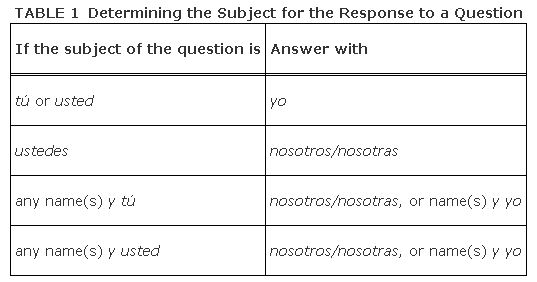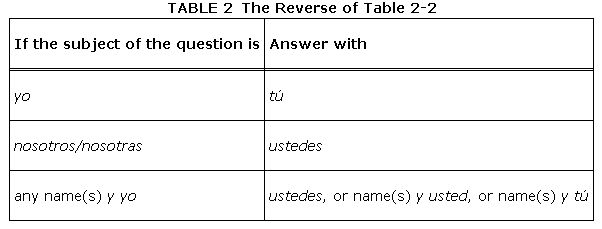Creating and Answering Questions
The simplest questions to create are “yes or no” questions. They are actually much easier in Spanish than they are in English. For example, how do you make a “yes or no” question out of the sentence, “Erin dates Mario”? You put the word “does” in front and change the form of the verb “to date.”
Does
Erin
date Mario?
The helping verb “to do” is rarely used in simple English sentences, although it is necessary for questions. An English “yes or no” question is formed using a helping verb. This verb has different forms including “do,” “does,” and in the past tense the form “did.” The sentences below use the helping verb forms “do” or “does”:
I do need this job. She does read a lot. Normally, it sounds funny to use a helping verb in a sentence, but when you want to make a “yes or no” question out of a sentence, the helping verb forms “do” or “does” are necessary. To form a question in English, the helping verb switches places with the subject of the sentence.
Even though you already know how to make a sentence into a “yes or no” question in English, it's helpful to realize that part of what you do is to switch the subject with the helping verb (“do” or “does”). The words “do” or “does,” however, do not translate in a Spanish question because Spanish does not use helping verbs to create questions; it simply switches the subject and the main verb. Don't, therefore, be tempted to find the Spanish equivalent of “do” or “does” when you see a question starting with “do” or “does” in English. Instead, you need to apply a simple, three‐step process to create the Spanish question.
1. Remove the “do” or “does” from the English question.
2. Translate the remaining sentence into Spanish, conjugating the verb to go with the subject.
3. Switch the subject with the verb and add the question marks.
Here's an example: Do I need this job?
Use the three‐step process to translate this into Spanish.
Remove the “do” or “does” from the English question ( I need this job).
Translate the remaining sentence into Spanish, carefully conjugating the verb to agree with the subject ( Yo necesito este trabajo).
Switch the subject and the verb and add the question marks (¿ Necesito yo este trabajo?).
To write a Spanish question that begins with a question word (such as “how,” “where,” “when”), start by pretending the question word is not there. Without the question word, you will be able to create a simple “yes or no” question by switching the subject and verb.
Most questions that begin with a question word are created exactly like a “yes or no” question, with the question word in front. Take the question “Does she speak Russian?” (¿Habla ella ruso?). Several question words could simply be placed in front of the question to elicit more information than a “yes or no” answer.
- How does she speak Russian?
- Where does she speak Russian?
- When does she speak Russian?
- Why does she speak Russian?
- ¿Por qué habla ella ruso?
- How much does she speak Russian?
All of the above questions can be created simply by first switching the subject and the verb to create a “yes or no” question, then placing the specific question word at the beginning of the sentence.
Some question words are used a little differently. These question words actually serve as the subject of the question. The question “Who speaks Russian?” uses the pronoun “who” as the subject. The pronoun quién is the subject of the Spanish question: ¿Quién habla ruso?
These questions are actually created in exactly the same way in Spanish and English, but since Spanish has both singular and plural versions of “who,” you have to think about one extra thing in Spanish: You must conjugate the verb to agree with the subject.
The singular pronoun quién is meant to represent one person, so use the él form of the verb, which is the form you would use if one person were the subject of the sentence. The plural version of who, quiénes, is meant to represent several people. It requires you to use the ellos form of the verb with it. (Note: When the question words quién and quiénes are preceded by a preposition such as a [ a quién] or de [ de quién], they will not be the subject of the sentence.)
- ¿ Quiénes juegan al vólibol?
- Who is playing volleyball? (assuming that more than one person is playing volleyball)
- ¿ Quién baila con Shakita?
- Who is dancing with Shakita? (assuming that only one person is dancing with Shakita)
Notice that when the question word serves as the subject, there is no need to switch the subject and verb. There are a few other question words that can act as the subject of the sentence.
- ¿ Cuántos asisten a la universidad? ( cuántos is the subject, asisten is the verb)
- How many attend the university? (“how many” is the subject, “attend” is the verb)
- ¿ Cuáles tienen más de diez cuartos?
- Which ones have more than ten rooms?
The question word cuántos can be used in another type of question. This is a simple “yes or no” question with the question word placed in front. For example:
- ¿ Come Julieta? ( Julieta is the subject, come is the verb)
- Does Julieta eat? (“Julieta” is the subject, “eat” is the verb)
As long as you have established what is being eaten, you can simply put the question word for “how many” in front of this “yes or no” question. In the above question, however, Julieta is the subject. If cuántos were the subject, the verb comer would be in the ellos form and Julieta would be the one being eaten.
- ¿Cuántos [tacos, burritos, etc.] come Julieta ? How many […] does Julieta eat?
The pronouns below can be used to create both kinds of questions. Questions using these pronouns will not always have the subject and verb switched, because sometimes the pronouns are actually the subject of the sentence. When this is the case, the verb will be conjugated in the él form if the question word is singular and in the ellos form if the question word is plural.

In answering a question, you must first listen for or look carefully at the subject used in the question to determine the correct subject to use in your response. You can either memorize the charts below (see tables and ) to determine how to answer the question, or you can think about which pronoun you'd use to answer the question in English. In other words, if a question is addressed to you, you'd answer with “I” both in English and Spanish. It is always better to understand than memorize. Once you understand tables and , you can refer to them while you are still learning, but you will quickly find that you no longer need to do so.


For example:
- ¿Hablas tú español? Sì, yo hablo español.
- Do you speak Spanish? Yes, I speak Spanish.
- ¿Hablan ustedes español? Sì, nosotros hablamos español.
- Do you guys speak Spanish? Yes, we speak Spanish.
- ¿Hablan Marco y tú español? Sì, nosotros hablamos español. Or Sì, Marco y yo hablamos español.
- Do you and Marco speak Spanish? Yes, we speak Spanish. Or Yes, Marco and I speak Spanish.
The reverse of these is also true. If the subject of the question isy o, the subject of the answer is tú and if the subject of the question is tú, the subject of the answer is yo. Since there are some options, you have to determine the specific pronoun depending on the context of the question.
When a question is asked about someone else, use either the person's name or the appropriate third person pronoun in your response. To answer these types of questions, you do not have to change the subject or the verb form. Simply answer sì or no, and put the subject back in front of the verb to change the question into a basic sentence. If there is a question word, fill in any information requested.
- ¿Baila ella? Sì, ella baila.
- Does she dance? Yes, she dances.
- ¿Trabaja Marìa? Sì, Marìa trabaja.
- Does Marìa work? Yes, Marìa works.
- ¿Cuándo trabaja Marìa? Marìa trabaja mañana.
- When does Marìa work? Marìa works tomorrow.
|
|
|
|
|
|
|
|
|
|
|
|
|